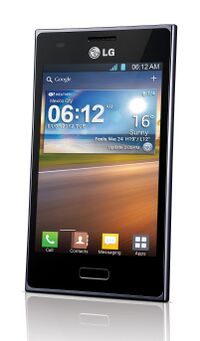LG Optimus L5 (lg-e610)
Appearance
| This device runs a Downstream kernel. Some UIs will not work, and most features (3D acceleration, audio, etc.) may be broken. |
 LG Optimus L5 | |
| Manufacturer | LG |
|---|---|
| Name | Optimus L5 |
| Codename | lg-e610 |
| Released | 2012 |
| Type | handset |
| Hardware | |
| Chipset | Qualcomm Snapdragon S1 (MSM7225A) |
| CPU | 800 MHz Cortex-A5 |
| GPU | Adreno 200 |
| Display | 320x480 |
| Storage | 4 GB |
| Memory | 512 MB |
| Architecture | armv7 |
| Software | |
Original software The software and version the device was shipped with. |
Android 4.0.3 |
Extended version The most recent supported version from the manufacturer. |
Android |
| postmarketOS | |
| Category | downstream |
Mainline Instead of a Linux kernel fork, it is possible to run (Close to) Mainline. |
no |
pmOS kernel The kernel version that runs on the device's port. |
3.4.0 |
Unixbench score Unixbench Whetstone/Dhrystone score. See Unixbench. |
135.2 |
| Device package |
|
| Kernel package |
|
Flashing Whether it is possible to flash the device with pmbootstrap flasher. |
Partial
|
|---|---|
USB Networking After connecting the device with USB to your PC, you can connect to it via telnet (initramfs) or SSH (booted system). |
Works
|
Battery Whether charging and battery level reporting work. |
Works
|
Screen Whether the display works; ideally with sleep mode and brightness control. |
Partial
|
Touchscreen |
Works
|
| Multimedia | |
3D Acceleration |
Untested
|
Audio Audio playback, microphone, headset and buttons. |
Untested
|
Camera |
Untested
|
| Connectivity | |
WiFi |
Broken
|
Bluetooth |
Untested
|
GPS |
Untested
|
| Modem | |
Calls |
Untested
|
SMS |
Untested
|
Mobile data |
Untested
|
| Miscellaneous | |
FDE Full disk encryption and unlocking with unl0kr. |
Untested
|
| Sensors | |
Accelerometer Handles automatic screen rotation in many interfaces. |
Untested
|
Contributors
- Nimayer
Maintainer(s)
- Nimayer
Users owning this device
- Fizzo (Notes: pmOS port author)
- IOrbitSaturn (Notes: Broken and planning to repair)
- J.r (Notes: Currently unused, will maybe play around with PmOS on it some day)
- Shipa (Notes: heavily used)
- Zekiu (Notes: vendor: "plus")
How to enter flash mode
From off state, press and hold ++, then release and hold the other two.
The phone will stay on the LG logo and show a black log screen once you connect the USB cable.
Internal memory Installation
| Flashing rootfs via fastboot does not work, try #SD card Installation instead |
Both pmbootstrap flasher flash_rootfs and pmbootstrap flasher flash_rootfs --partition userdata
fail with:
[12:50:20] (native) flash rootfs image target didn't report max-download-size Sending 'userdata' (464896 KB)... FAILED (remote: data too large)
You can flash by recovery zip or SD card.
SD card Installation
- Build image (on your computer) and prepare the installation as usual
$ pmbootstrap init $ pmbootstrap build device-lg-e610 $ pmbootstrap install --sdcard=/dev/mmcblk0
- Put the phone in Fastboot mode and connect it to your computer
$ pmbootstrap flasher flash_kernel
Issues
- LightDM doesn't show up on the screen by default. To fix this you need to add
logind-check-graphical=falsein/etc/lightdm/lightdm.conf. See Display_manager#CanGraphical_issue for more info. - PulseAudio reboots the device. This is particularly problematic in Xfce, since it launches PulseAudio at startup. To make Xfce usable, you may want to uninstall the pulseaudio package or delete the /usr/bin/pulseaudio binary. (apparently Samsung Galaxy Young (samsung-royss) also has this problem?)
- console and fbkeyboard user interfaces don't show the actual console.
It might be becauseCONFIG_FRAMEBUFFER_CONSOLEis disabled. But rebuilding the kernel with this option enabled causes a kernel panic. - Loading module blobs doesn't seem to work when the kernel is compiled with gcc-6. Downgrading to gcc-4 sort of fixes the issue, but WiFi fails to load anyway.
See also
- pmaports!340 Initial merge request